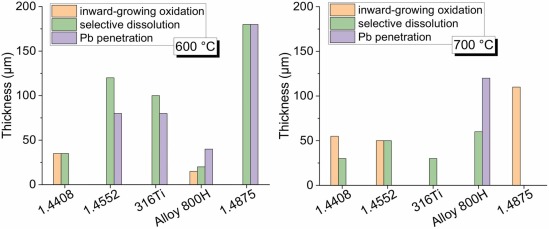A. Purwitasari, C. Oskay, A. Heinzel, R. Fetzer, A. Weisenburger, G. Müller
Corrosion Science (244) (2025), 11265,1DOI: 10.1016/j.corsci.2024.112651

 Fig. 22: Graphical summary of results after 5000 h exposure tests.Reprinted from Corrosion Science with permission from Elsevier according to the Creative Commons license.
Fig. 22: Graphical summary of results after 5000 h exposure tests.Reprinted from Corrosion Science with permission from Elsevier according to the Creative Commons license.
Liquid lead is an attractive candidate to be used as heat transfer medium for heat transfer and storage systems due to its excellent heat transfer characteristics and wide applicable temperature range. This study explores the material compatibility of five different austenitic stainless steels (two cast and three wrought steels) and investigates the possibility to extend their use up to 700 °C. From static exposure tests with up to 5000 hours duration, the corrosion behavior of each steel is characterized. Comparison of the different materials allows conclusions on the influence of individual alloying elements and of the material’s grain size.